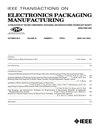Combined Parameter and Tolerance Design for Quality via Computer Experiment: A Design for Thermoelectric Microactuator
IEEE Transactions on Electronics Packaging Manufacturing
Pub Date : 2008-07-09
DOI:10.1109/TEPM.2008.926286
引用次数: 15
Abstract
A thermoelectric microactuator is examined with a computer experimental approach based on the asymmetrical thermal expansion of the microstructure with two beams of different widths. Because a typical U-shaped lateral thermoelectric actuator is used, the remaining concerns are the associated parameters and tolerance values that need to be determined. Conventional approaches consider that parameter and tolerance variables are two unconnected controllable variables, with the condition that the analytical functions representing the design of interest are known. A belief that the two variables are unconnected, usually fails to find truly optimal solutions, particularly a belief that the design functions are nonlinear in a complicated design. Assuming that design functions are normally known is a mistake in most cases, especially in the early stage of design. In this regard, a simultaneous parameter and tolerance design accompanying the computer experiment is developed to ensure that true optimization is achieved. The computer experimental approach consists of both a computer simulation and a statistical method. In this paper, the computer simulation is performed with existing computer-aided engineering (CAE) software, and ANSYS, the finite-element method for the solution of coupled 3-D mechanical problems. The statistical method is one of a design experimental approach such as response surface methodology (RSM). The response value is the conformation rate used in measuring product quality for uncertain conditions. This approach provides designers not only with optimal parameter and tolerance values, but also with the importance ranking for the controllable variables of a product. This is particularly important for the evolutionary design processes in an uncertain environment.计算机实验质量参数与公差组合设计——热电微动器的设计
采用计算机实验方法,研究了两束不同宽度的热电微动器微结构的不对称热膨胀现象。由于使用了典型的u型横向热电执行器,因此需要确定的问题是相关参数和容差值。传统方法认为参数变量和容差变量是两个不相连的可控变量,条件是表示目标设计的解析函数是已知的。认为这两个变量是不相关的,通常无法找到真正的最优解,特别是在复杂设计中认为设计函数是非线性的。假设设计功能通常是已知的,在大多数情况下是错误的,特别是在设计的早期阶段。为此,提出了伴随计算机实验的同步参数和公差设计,以确保实现真正的优化。计算机实验方法包括计算机模拟和统计两种方法。本文利用现有的计算机辅助工程(CAE)软件和求解耦合三维力学问题的有限元方法ANSYS进行了计算机仿真。统计方法是一种设计实验方法,如响应面法(RSM)。响应值是在不确定条件下用于测量产品质量的符合率。该方法不仅为设计人员提供了最优参数和公差值,还为设计人员提供了产品可控变量的重要性排序。这对于不确定环境中的进化设计过程尤为重要。
本文章由计算机程序翻译,如有差异,请以英文原文为准。
求助全文
约1分钟内获得全文
求助全文

 求助内容:
求助内容: 应助结果提醒方式:
应助结果提醒方式:


